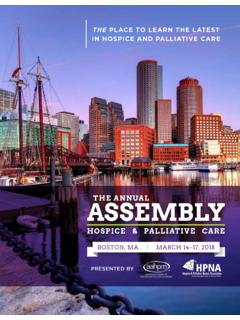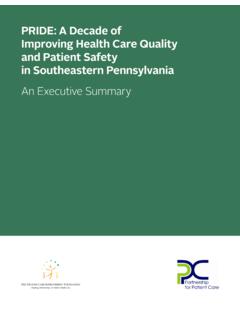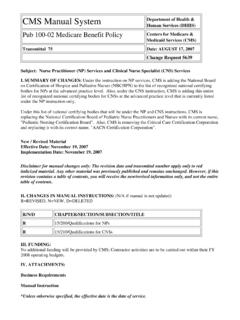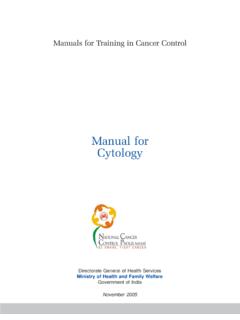Transcription of Guidance for staff responsible for care after death
1 Guidance for staff responsible for care after death (last offices) National NurseConsultant Group( palliative care )Developed by the National End of Life care Programme and National Nurse Consultant Group ( palliative care )The Royal College of PathologistsPathology: the science behind the cureContents1 Foreword2 Introduction4 Pathways of care for the deceased person5 care before death6 care at the time of death7 Best practice and legal issues8 care after death10 Personal care after death12 Transfer of the deceased person13 Recording care after death14 Glossary14 Appendix 1: deaths requiring coronial investigations15 Appendix 2: information required by mortuary staff and funeral directors15 Appendix 3: key stakeholders involved in the development of this guidanceTo be reviewed: April 20141 Caring for a person at the end of their life, and after death , is enormously important and a privilege.
2 There is only one chance to get it right and it is not at all easy to coordinate everything that needs to happen. This Guidance will help with DH End of Life care Strategy (2008) for England set out a pathway of care covering each step in the end of life care journey. This document is written for all health and social care professionals, who care for the person who has died and their carers, and details the key elements of care provision in the immediate period following death the final step of the end of life care pathway. Responsibilities for caring for the deceased moves between differing professions and teams - nurses, doctors, porters, mortuary staff , pathologists, coroners, funeral directors and bereavement teams and implementation of this Guidance will help prevent either duplication of roles or gaps in care provision. In developing this Guidance there was a review of the evidence base and then four rounds of consensus building for those areas of practice not yet fully researched.
3 Throughout this process, over one hundred individuals representing all organisations with a responsibility for caring for people after death have demonstrated a willingness to work together and share professional expertise. We view these people as our partners in this work and they have shaped a cogent and cohesive pathway for delivery of care after death that honours the integrity and wishes of the person who has died. Importantly, it also puts the deceased and their carers at the focus of the care , whilst balancing the needs of the legal and coronial system and the health and safety of Guidance is designed to underpin training for all those involved in the pre-registration curriculum, post registration training, professional training and the training of carers and will helpfully affect how we can explain good practice in this sensitive area of practice in the recognise and acknowledge the important role that all staff play in caring for the deceased and their carers.
4 It is a rewarding area of care , but the lack of clear Guidance and training can make it challenging. This Guidance and the associated e-learning modules are an important step in addressing this Henry Director National End of Life care Programme Jo WilsonMacmillan Consultant Nurse PractitionerNational Nurse Consultant Group palliative care The nurses role at the end of life extends beyond death to provide care for the deceased person and support to their family and carers. The physical care given by nurses following death in hospitals has traditionally been referred to as last offices . However, in this Guidance we refer to care after death , a term more befitting of our multi-cultural Guidance does not use the term last offices because we wish to move away from the link with the military and religious origins of nursing and the association with last rites , a Christian sacrament and prayer administered to the dying1, and because last offices only applies to the physical preparation of the new terminology care after death is intended to reflect the differing nursing tasks involved, including on-going support of the family and carers.
5 The physical preparation of the body itself will be called personal care after death .The person who provides the care after death takes part in a significant process which has sometimes been surrounded in ritual. Although based on comparatively straightforward procedures, it requires sensitive and skilled communication, addressing the needs of family members/carers and respecting the integrity of the person who has died. It is a very difficult time for those who have been bereaved and can be emotionally challenging for after death is a key responsibility for registered nurses in In other settings (such as care and nursing homes, hospices and people s own homes) those responsible can also include carers, social care staff , GPs and funeral diagram on page 4 shows that care after death , while being the last act of nursing care , is the first stage of a pathway that involves a range of professional groups.
6 This process leads ultimately to cremation or burial of the involved in this pathway include doctors, mortuary staff , hospital porters, ambulance staff , bereavement officers, police, social care staff , funeral directors, pathologists, coroners and faith leaders. Co-ordinated working between these individuals and organisations is vital if the process is to run after death includes: Honouring the spiritual or cultural wishes of the deceased person and their family/carers while ensuring legal obligations are met Preparing the body for transfer to the mortuary or the funeral director s premises Offering family and carers present the opportunity to participate in the process and supporting them to do so Ensuring that the privacy and dignity of the deceased person is maintained Ensuring that the health and safety of everyone who comes into contact with the body is protectedIntroduction1 Nursing care of dead bodies: a discursive analysis of last offices, B Quested/T Rudge, Journal of Advanced Nursing, Mar 2003 (vol 41, issue 6) pp 553-60 2 Till death us do part?
7 The nurse s role in the care of the dead: a historical perspective: 1850-2004, C Blum, Geriatric Nursing, Jan-Feb 2006 pp 58-6323 Honouring people s wishes for organ and tissue donation Returning the deceased person s personal possessions to their nature of the death and the context in which it has occurred affects how care is provided, as well as the level of support needed by those who have been bereaved. For example, some deaths are expected or peaceful while others may be sudden or traumatic. As a result, families and carers are likely to have a range of responses and needs and each may also have differing views about how the person should be cared for after death . They may be very protective of the deceased person, feeling that their loved one has suffered enough .3 Appropriate and sensitive nursing care at this time is therefore Guidance is for nurses and those who have nursing tasks delegated to them.
8 It is also relevant for all health and social care professionals who work with people at the end of life, having been written with the co-operation of a wide range of related professional organisations. It sets out key principles and is intended as a guide for training, as well as for informing the development of organisational protocols for this area of care . It also aims to provide a consistent view that accommodates England s diverse religious and multi-cultural beliefs. Existing work has been referenced where possible. Where published research was not available, a consensus4 approach was taken, based on nationally recommended guidelines developed by the Royal Marsden Hospital5 and involving key national stakeholders (see appendix 3). The National Nurse Consultant Group ( palliative care ) led the project, working with the National End of Life care Programme, the Department of Health and other term family , rather than next of kin , has been used throughout because it is more representative of modern living arrangements, where people involved may not all be blood relations.
9 With respect to organ donation and postmortem, however, consent needs to be sought from the person with the highest qualifying familial Guidance relates to other concurrent national work:n NICE development of and consultation on the end of life care Quality Standard n DH revision of the 2005 Guidance When a Patient Diesn Revision by Cruse Bereavement care and the Bereavement Services Association of the 2001 document by the London Bereavement Network which it called Standards for bereavement care in the UK*n Introduction of new regulations on death certification new e-learning modules will also support the implementation of this Guidance . They are being developed by End of Life care for All (e-ELCA), commissioned by the Department of Health and the National End of Life care Programme and delivered by e-learning for Healthcare (e-LfH), in partnership with the Association of palliative Medicine of Great Britain and Ireland.
10 For more information, go to *The London Bereavement Network no longer exists. Standards for bereavement care in the UK does not reflect the views of the Department of Health and will be renamed as part of its 2011 revision. 3 Why relatives do not donate organs for transplant: sacrifice or gift of life ?, Sque et al (2007), Journal of Advanced Nursing, Jan 2008 (vol 61, issue 2) pp 134-44 4 Consensus methods for medical and health services research, J Jones/D Hunter, British Medical Journal, 5 Aug 1995 (vol 311, issue 7001) pp 376-80 5 The Royal Marsden Hospital manual of clinical nursing procedures (seventh edition), L Dougherty/S Lister (editors), 2008 6 Code of practice 1: consent (Consent requirements part 2: tissue from the deceased), Human Tissue Authority, 2009 Pathways of care for the deceased person4 Fact of death is verified Transfer to theatre for organ donationMCCD issuedDiscuss with coronerReport/refer to coroner*Form 100A/BissuedPerson diesPerson is dyingPersonalcare ofthedeceasedTransfer to mortuary/possible post- mortem, & possible tissueretrievalTransfer to undertaker & possible tissue retrieval Burial or cremationReturn deceased person s propertyIncorporate deceased person s wishes about care arrangementsSupport/information for family/carersSign cremation forms/medical examiner s confirmation of death (when death certificate regulations are introduced) death registered and death certificate issued by registrarIn home and care home settings the deceased person will not transfer to theatre for organ donation.






